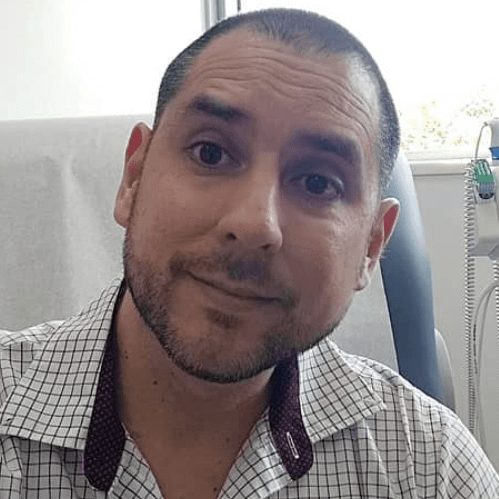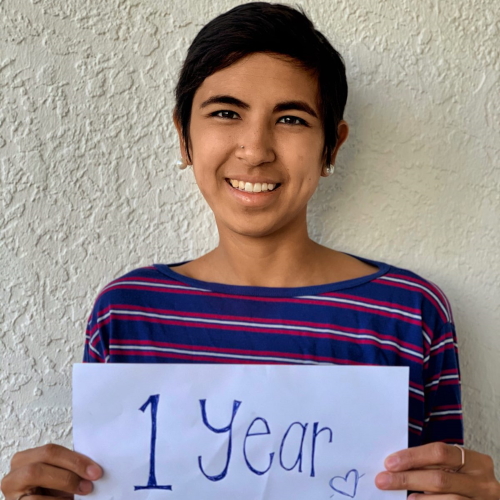Cancer Remission
Is cancer ever ‘cured?’ Cancer remission, cures, and coping with recurrence

Fighting cancer is a battle for life, but are you ever really ‘cured’? We’ve assembled stories from patients, caregivers, and medical professionals to talk about what remission really means and how to cope with the anxiety of follow-up scans (“scanxiety”) and the threat of recurrence.
But the short answer is remission is always something to celebrate!
What does cancer remission mean?
After you’ve completed cancer treatment, your doctor may tell you you’re ‘in remission’. That’s awesome! But what does that mean? It means more than simply finishing treatment.
In general, remission broadly refers to a decrease or absence of cancer for at least one month. Doctors can monitor this through scans, bloodwork, and physical exams. You may also notice less pain and other symptoms of disease. It’s time to take a breath and enjoy the moment.
There are two types of remission: partial and complete.
Partial remission
Partial remission is often used to describe cancer that is still evident but has gotten smaller or is reduced overall. Patients with ‘chronic’ cancers (like certain types of leukemia) sometimes go into partial remission.
This means your oncologist may recommend a break from treatment while monitoring for any changes. Some people end up on a reduced treatment plan, meaning treatment may be less aggressive.
Complete remission
Complete remission is often listed on medical reports as ‘No Evidence of Disease’ (NED). There must be no evidence of disease for at least one month to be considered in complete remission.
Cure vs. remission
Doctors are hesitant to ever use the word ‘cured‘ following cancer treatment. Even though there may be no obvious evidence of cancer via scans and bloodwork, it is impossible to tell if the cancer is 100% gone.
It is possible for cancer cells to come back, and it’s most likely that it can come back in the first five years following cancer treatment. When it comes to complete remission, there is no special term for remission at the 5- or 10-year mark (or more!).
You may, however, hear the term ‘cancer-free’. Again, it doesn’t mean the cancer won’t come back, but doctors feel confident that there is no evidence of cancer.

It was crazy because two-and-a-half months earlier, my whole body was loaded with these cancerous white blood cells from top to bottom, stage four. And two-and-a-half months later, there’s no evidence of any disease in me? How is that possible? It was miraculous.
Sheryl B.
How do you get to cancer remission?
That’s a complicated question. Cancer treatment is based on the stage at the time of diagnosis, the type of cancer, and other health considerations.
Your doctor will assess your unique case and determine a course of action. Some may choose more aggressive treatment. You may have one or a combination of the following treatments:
Even though these treatments may help kill or reduce cancer cells, they can also come with side effects that are challenging to manage and live with. Long-term side effects are another concern.
Ways to help stay in remission
Some patients undergo maintenance therapy, which could be low doses of cancer treatments to help keep the disease from advancing or returning. Not all cancer patients do maintenance therapy.
Since this is a cancer with no cure, this maintenance helps extend your remission time. I visit my oncologist every three months to look at my blood tests. I am hoping the cancer stays away for a long time.
Carlos C.

After cancer treatment, many people try to adopt a healthier lifestyle in order to prevent recurrence. It’s not a guarantee, but the following lifestyle changes may help:
- Eat more fresh fruits, vegetables, and whole grains
- Quit smoking (or don’t start)
- Maintain a healthy weight
- Drink alcohol in moderate amounts
- Exercise regularly
- Try to maintain good mental health and stress management
It’s been years. I still feel like I’m healing and recovering, but at the same time, I surprisingly feel as healthy as I ever have. I practice yoga a lot these days, and I can bend in some fun ways.
Alicia B.
Survival statistics
When you’re dealt a cancer diagnosis, the natural question is: ‘What are my chances of survival?’ That’s not a one-size-fits-all question, but there are statistics that can help inform.
Survival statistics are based on large groups of people with the same diagnosis. You may see the following statistics:
- Survival rate: This notes the percentage of people with a specific cancer alive for a certain amount of time after diagnosis (1, 5, 10 years, etc.)
- Overall survival rate: The percentage of people with a specific stage and type of cancer who have survived for a certain period of time after diagnosis.
Most researchers look at 5-year survival rates because the chance of recurrence after 5 years is statistically lower for most cancer types.
When you’re first diagnosed, and you look up survival statistics, they’re terrifying. You act as if you should die before you finish reading the paragraph. The key thing is, in order to have survival statistics, they have to be based on old number because these are people who have already died. So, what’s going in the future must be better.
Dr. D. Ross Camidge

Scanxiety
Scanxiety is a term that grew out of necessity. It describes the anxiety that cancer patients and survivors feel leading up to X-rays, CT scans, MRIs, PET, and other diagnostic tools that will show cancer status. Some researchers believe that scanxiety may relate to post-traumatic stress disorder.
Learning how to cope with fear of the unknown can help ease this type of anxiety. Breathing and meditation exercises, healthy distractions, and therapy can all help reframe your mindset.

I took a mindfulness class that helped me slow down my reaction to thinking. I learned that you can’t control what you think and feel, but you can influence how you react to those thoughts and feelings. It calmed me down.
Stephanie Chuang, The Patient Story founder
Understanding recurrence
In the months and years following cancer treatment, there is a chance that cancer can come back, which is known as ‘recurrence’. Recurrence can occur in the same location as the original cancer, but it could possibly occur elsewhere in the body.
Unfortunately, there is no way to know if you will experience a recurrence. It’s absolutely critical to follow your doctor’s advice and follow up with all recommended scans and lab work.
Coping with recurrence
A recurrence can revive old feelings of fear and anxiety, but there are ways you can cope.
You know more now than you did the first time. You know what to expect with scans and how to cope with treatment. Treatments have also likely improved since the first time. Cancer treatments are developing day by day.
Additionally, you know your healthcare team — and they know you! There’s comfort in knowing you have a team ready to support you. Because you’ve been through this before, you may already have some coping strategies in your back pocket like yoga, journaling, and support groups.
Surviving cancer
Survivorship means different things to different people, but the American Cancer Society uses the term ‘cancer survivor’ to describe anyone living who has received a cancer diagnosis. Other people use the term survivor to describe those who have completed treatment.
Some don’t wish to use the term at all. Life with and after cancer will manifest differently in everyone because our lives are all based on unique experiences.
Regardless of the language you choose to use (or not), remission is something to celebrate.
Want to share your story?
Feel free to fill out our Get to Know You form!

One reply on “Cancer Remission”
Hi, my name is Rohan! I am an SF Bay Area native and I was diagnosed with AML in 2023 at just 27 years old—an uncommon age for this disease. With no matched donor available, not even a partial match, I received a cord blood bone marrow transplant. I’m now 9 months in remission and incredibly grateful to be here still and share my story. I also want to raise awareness to the Asian American community about joining the registry because of what happened with me.